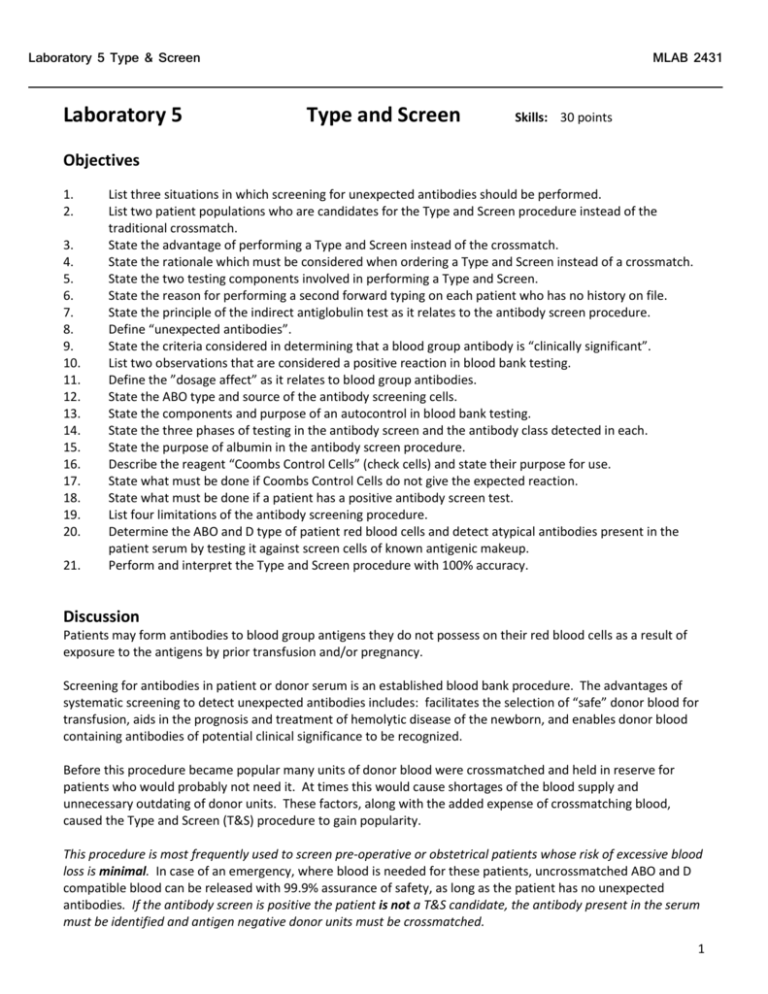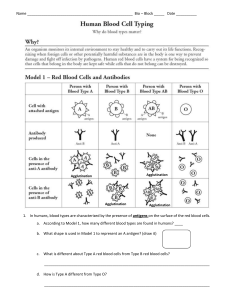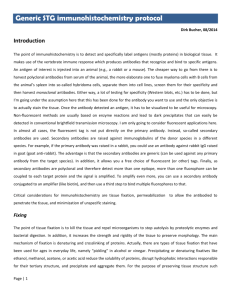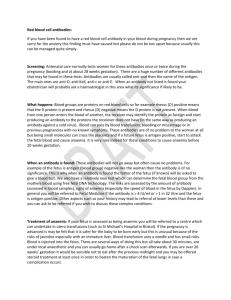Type and Screen Lab: ABO/D Typing & Antibody Screening
advertisement

Laboratory 5 Type & Screen Laboratory 5 MLAB 2431 Type and Screen Skills: 30 points Objectives 1. 2. 3. 4. 5. 6. 7. 8. 9. 10. 11. 12. 13. 14. 15. 16. 17. 18. 19. 20. 21. List three situations in which screening for unexpected antibodies should be performed. List two patient populations who are candidates for the Type and Screen procedure instead of the traditional crossmatch. State the advantage of performing a Type and Screen instead of the crossmatch. State the rationale which must be considered when ordering a Type and Screen instead of a crossmatch. State the two testing components involved in performing a Type and Screen. State the reason for performing a second forward typing on each patient who has no history on file. State the principle of the indirect antiglobulin test as it relates to the antibody screen procedure. Define “unexpected antibodies”. State the criteria considered in determining that a blood group antibody is “clinically significant”. List two observations that are considered a positive reaction in blood bank testing. Define the ”dosage affect” as it relates to blood group antibodies. State the ABO type and source of the antibody screening cells. State the components and purpose of an autocontrol in blood bank testing. State the three phases of testing in the antibody screen and the antibody class detected in each. State the purpose of albumin in the antibody screen procedure. Describe the reagent “Coombs Control Cells” (check cells) and state their purpose for use. State what must be done if Coombs Control Cells do not give the expected reaction. State what must be done if a patient has a positive antibody screen test. List four limitations of the antibody screening procedure. Determine the ABO and D type of patient red blood cells and detect atypical antibodies present in the patient serum by testing it against screen cells of known antigenic makeup. Perform and interpret the Type and Screen procedure with 100% accuracy. Discussion Patients may form antibodies to blood group antigens they do not possess on their red blood cells as a result of exposure to the antigens by prior transfusion and/or pregnancy. Screening for antibodies in patient or donor serum is an established blood bank procedure. The advantages of systematic screening to detect unexpected antibodies includes: facilitates the selection of “safe” donor blood for transfusion, aids in the prognosis and treatment of hemolytic disease of the newborn, and enables donor blood containing antibodies of potential clinical significance to be recognized. Before this procedure became popular many units of donor blood were crossmatched and held in reserve for patients who would probably not need it. At times this would cause shortages of the blood supply and unnecessary outdating of donor units. These factors, along with the added expense of crossmatching blood, caused the Type and Screen (T&S) procedure to gain popularity. This procedure is most frequently used to screen pre-operative or obstetrical patients whose risk of excessive blood loss is minimal. In case of an emergency, where blood is needed for these patients, uncrossmatched ABO and D compatible blood can be released with 99.9% assurance of safety, as long as the patient has no unexpected antibodies. If the antibody screen is positive the patient is not a T&S candidate, the antibody present in the serum must be identified and antigen negative donor units must be crossmatched. 1 Laboratory 5 Type & Screen MLAB 2431 There are hundreds of different antigens on the human red blood cell. So far we have studied the ABO and Rh (D) antigens and performed testing to detect the presence or absence of these antigens. The “other” blood group antigens are not very immunogenic but some individuals who have been exposed to these antigens through previous transfusions or pregnancy may be exposed and recognize one or more of these as foreign, resulting in the formation of an antibody which will react with the specific antigen(s) which caused their production. Screening for the presence of unexpected antibodies in patient or donor serum is an established blood bank procedure. The antibody screen, also known as the indirect antiglobulin test (IAT), involves testing the patients’ serum against reagent red blood cells selected to possess relevant blood group antigens for detection of clinically significant, unexpected antibodies. The term “unexpected antibodies” refers to those antibodies other than anti-A or anti-B. It is expected that a group A person will have anti-B in their serum. The lack of expected ABO antibodies will result in the need for additional testing. Clinically significant antibodies are of the IgG class and react in-vitro, preferentially at 37 C or at the anti-human globulin phase of testing. These antibodies were determined to be clinically significant if they have been responsible for hemolytic transfusion reactions or hemolytic disease of the newborn. Simply stated, they are responsible for red blood cell destruction. In-vitro hemolysis and/or agglutination of the screen cells by the patient serum/plasma at any of the various phases of testing constitutes a positive test result and indicate the presence of unexpected antibodies which could possibly cause in-vivo hemolysis which may manifest as decreased survival of transfused red blood cells or hemolytic disease of the newborn. Antibodies that are reactive at 37°C and/or in the anti-human globulin test are more likely to be significant than those reactive at room temperature or below. A positive reaction is obtained in the antibody screen will result in the need for addition testing to determine the specificity of the antibody so that appropriate antigen negative donor units can be selected. Screening for antibodies in patient or donor serum or plasma has the advantages of: Facilitating the selection of “safe” donor blood for transfusion Aids in the prognosis and treatment of hemolytic disease of the fetus and newborn Enables donor blood containing antibodies of potential clinical significance to be recognized The absence of hemolysis and/or agglutination constitutes a negative test indicating the serum/plasma being tested does not contain detectable antibodies directed to any of the wide variety of antigens present on the reagent screen cells. Although two cell screens are available a three cell screen is recommended, especially for those facilities who routinely utilize a Type and Screen (T&S) instead of a crossmatch or who perform an abbreviated crossmatch procedure (the abbreviated crossmatch will be discussed in Lab 6). A three cell screen provides cells which are homozygous for the antigens to which individuals most frequently make antibodies. This helps ensure the detection of weakly reactive antibodies. Some antibodies are so weak that they may show a dosage effect. In dosage effect the antibodies may react most strongly or ONLY with cells which are homozygous (have a double dose of the antigen, i.e., Fya+Fyb=) and give negative or weakly reactive results with heterozygous cells (have single dose of antigen, i.e., Fya+Fyb+). The heterozygous cells possess half as much antigen as the homozygous cells which may result in weak or negative reactions. The screening cells are supplied as three vials, each containing a suspension of human group O red blood cells derived from a single donor. These red blood cells have been phenotyped for the antigens to which patients most frequently make antibodies to. The results of this typing are provided on a piece of paper known as an Antigram. A “+” in the column under the antigen indicates the cell has been tested and found to be positive for the antigen, a “0” indicates the cell has been tested and found to be negative for the antigen. It is critically important that the lot number on the Antigram match the lot number on the screen cells. Each lot number of screen cells will have different donors which will change the antigenic make up. 2 Laboratory 5 Type & Screen MLAB 2431 In some laboratories the patient's red cell are tested with their serum as an autologous (auto) control, by the same method used for the antibody detection test. This procedure is done to detect antibodies which are coating red cells in the patient’s circulation. AABB Standards does not require that an autologous control be done. It has been found that even when it is positive; it is of limited value in pretransfusion testing. When the auto control is positive additional testing must be performed (DAT, possibly an eluate, etc.). The information obtained from these tests rarely changes the selection of blood for transfusion when the antibody screen is negative and usually causes an unnecessary delay in getting blood to the patient. Auto controls are routinely performed when an antibody workup is done. Principle This procedure consists of two (2) parts: 1. Performing a complete ABO and D typing on the patient's blood sample. 2. Screening the patient's serum for atypical antibodies using three reagent screen cells. The principle of the ABO and D typing procedure was covered in Exercise 3, please review it. AABB requires that all patients without a history have a second ABO/D typing done as part of the testing process. If a discrepancy occurs between the two sets of tests, then testing must be repeated. The principle of the antibody screen is as follows: well mixed antibody screen cells of known phenotypes are added to patient serum and are evaluated/read at three different phases to determine if there is an unexpected antibody in the patient’s serum which is reacting with a blood group antigen present on the reagent screen cells constituting a positive reaction. You must memorize each phase and the antibody class most commonly detected by each phase. Saline Immediate Spin (IS) Phase This phase provides a condition that best allows the detection of IgM class antibodies. Due to their structure, antibodies of the IgM class readily agglutinate red cells suspended in saline. Patient serum is added to the 3 screen cells; the tubes are immediately spun down and observed for hemolysis and/or agglutination by gently resuspending the cell button. If a positive reaction is obtained at this phase, proceed to the incubation and antiglobulin phase to see if the reaction goes away or gets stronger. Reactivity at IS only usually indicates the presence of a “nuisance” cold reactive antibody. Additional testing would be necessary to confirm this. Albumin, 37°C Incubation Phase Bovine serum albumin or some other additive is used to enhance agglutination of red blood cells by antibodies of the IgG class. One theory states that the albumin reduces the zeta potential (electrical charges) between the red blood cells, allowing them to come closer together. This may allow the small IgG molecules to bridge the gap between the red cells allowing lattice formation (agglutination) to occur. Albumin affects the second stage of agglutination. There are several other enhancement mediums used routinely in the blood bank including LISS, PEG, and others. You will gain experience with some of these during your clinical rotation. The IgG antibodies are sensitized at 37C; however, most of the time the antigen-antibody reaction requires AHG for lattice formation. If an antibody is reactive at this phase in vitro (in the test tube) then it may also react in vivo (in the body). 3 Laboratory 5 Type & Screen MLAB 2431 After the incubation phase, all tubes are again spun down and observed for agglutination and/or hemolysis by gently dislodging the cell button and record the graded reactions. If a positive or negative reaction is obtained at this phase proceed to the AHG phase. Anti-human Globulin Phase (AHG or Coombs phase) Many antibodies of the IgG class are small and do not always cause visible agglutination. During the incubation phase, the antibodies may attach to antigens on individual red cells (sensitize) but, due to their small size, cannot cause agglutination. To determine if sensitization has occurred, all tubes are washed three times with saline to remove the serum and albumin. Anti-human globulin (AHG or Coomb's) serum is added to all tubes. AHG is an anti-IgG antibody which will attach to antibodies coating the cells. The tubes are spun down and again evaluated for agglutination both macroscopically and microscopically. This is the most important phase of the procedure because most clinically significant antibodies are of the IgG class and may only react at the anti-human globulin phase. It is critical that you memorize the principle of this test and be able to create a drawing to illustrate the principle. Some clinical instructors will require you to do this as part of your blood bank rotation. Control Cells (Check Cells or IgG coated red blood cells) There are many potential sources of error in the anti-human globulin procedure. Washing must be thorough to remove all unbound antibody. As little as one drop of a 1:4000 dilution of human serum can neutralize one drop of anti-human globulin testing sera. Human serum contains IgG antibodies to any disease or vaccine which we have become immune. Failure to wash sufficiently or resuspend the cell button in between washes may result in unbound IgG in the test tube. The free IgG will preferentially bind to the anti-IgG (AHG) which results in neutralization of the reagent. To ensure that this has not occurred, and that the AHG is active, control cells (check cells) are added to each negative reacting tube. Control cells are commercially prepared, sensitized reagent red blood cells (cells coated with IgG antibody). If the AHG is active, and has not been neutralized, a positive reaction will be obtained. If a negative reaction is obtained after the check cells are added, the test procedure is invalid and must be repeated. The most common cause of check cells not “checking” is insufficient washing. Refer to your Lecture Guide and textbook for the many causes of false positive and false negative reactions at the AHG phase (Coomb's procedure). You MUST know the possible causes of false negative/positive reactions. This will enable you to problem solve and trouble shoot unexpected problems encountered in the testing procedure. Limitations of the Procedure In all serological tests, such factors as contaminated materials, improper incubation or temperature, improper centrifugation or improper examination for agglutination may give rise to false results. Other limitations of antibody detection and identification tests include: 4 Laboratory 5 Type & Screen MLAB 2431 1. The use of plasma or aged serum may result in failure to detect complement dependent antibodies. 2. The antibody in the serum being tested may be directed at an antigen not represented on the reagent red blood cells (low incidence antigen). 3. The patient may have antibodies to components of the preservative solution in the reagent screen cells. 4. The patient may have antibodies to a component in the bovine albumin. Most transfusion services use LISS (low ionic strength solution) to avoid the problem with albumin. Procedure A. Specimen Preparation and Rack Set-up 1. Label two tubes with the patient's complete name and hospital number. 2. Place approximately 2-3 drops of cells in the second tube. 3. Fill the tube containing the red cells with saline, spin for one minute. Spin the serum tube as well if necessary. Decant the saline completely form the red blood cells and add enough saline to create a 3-5% cell suspension. 4. While the serum and cells are spinning, label tubes and arrange in test tube rack as shown. Place the retype tubes directly behind the first set. (Gray space indicates empty slots for tubes.) Patient Sample Patient Washed RBCs R-A anti-A R-B anti-B R-D anti-D Patient Serum/Plasma A1 cells B cells S1 S2 S3 REMEMBER: Patient initials at the top of each tube. Patient's full name and hospital number on serum and cells. B. Type and Screen 1. Add one (1) drop of each appropriate reagent anti-sera to the ABO/D labeled tubes. 2. Add two (2) drops of patient serum to A1 cell, B cell, S1, S2, and S3 tubes. 3. Visually inspect all tubes at this time to make sure that all serum has been added. 4. Add one (1) drop of the patient washed cell suspension to the forward (ABO/D) typing tubes. 5. Add one (1) drop of reagent A1 cell, B cell, S1, S2, and S3 cells to the appropriately labeled tubes. 5 Laboratory 5 Type & Screen MLAB 2431 6. Spin S1, S2 and S3 tubes in the serofuge for 15-20 seconds. 7. Read each of these tubes for agglutination and/or hemolysis. Record results as each tube is read. 8. Add two (2) drops of LISS to S1, S2 and S3 tubes and place in 37C incubator for 15 minutes. 9. Spin the ABO/D and reverse test tubes for 15-20 seconds. 10. Read for agglutination. Record these results now. If the patient appears to be D negative set up the D ctrl tube and immediately place the anti-D and D ctrl tubes in the 37C water bath for 15 minutes (if this is done quickly the incubation should be completed at the same time as the antibody screen). NOTE: If patient appears to be AB positive, a D control must be run. 11. During incubation, retype your patient using the stick method of the drop method from the last laboratory procedure. Read and record results. 12 After the 15 minute incubation, spin the S1, S2 and S3 for 15-20 seconds. 13. Read each tube for agglutination and/or hemolysis. Record results as each tube is read. 14. Wash the S1, S2 and S3 (and anti-D and D ctrl tube if your patient appeared to be D negative) three (3) times with saline. 15. AHG Phase Washing Procedure Notes a. Washing process must be carried out in the shortest time possible. b. Completely resuspend cell buttons after each wash, visually inspect bottom of tubes after addition of saline, if an RBC button is visible resuspension was not achieved and an additional wash should be performed. c. Spin time is one minute for each wash. d. Completely decant saline between each wash, turn tubes over and allow saline to drain, do not shake the tubes as they are draining, this will result in the loss of your RBCs. e. After the third wash, decant completely and blot the rims of the tubes dry with Biowipes to produce a dry cell button. Add two (2) drops of anti-human globulin (AHG) reagent to each tube, resuspend the cells completely and spin for 15-20 seconds. NOTE: Make sure you are adding AHG, which is green, and NOT Coombs control cells, which is a cell suspension! 16. Read for agglutination macroscopically and microscopically. Record results after reading microscopically. 17. To all tubes showing a negative reaction add one (1) drop of check cells (IgG coated red blood cells). Mix well and spin for 15-20 seconds. 18. Read for agglutination macroscopically. At least a 1+ reaction must be obtained in each test tube after the addition of check cells or all results are invalid. Record results of the check cells by grading the agglutination. 6 Laboratory 5 Type & Screen MLAB 2431 Interpretation of Results If all three (3) screen cells give negative results throughout all three phases of testing, the interpretation of the test is “negative”. If one (1) or more of the screen cells is positive (agglutination and/or hemolysis of the test RBCs has occurred), the interpretation of the antibody screen is “positive.” This is indicative of an antibody present in the patient's serum reacting with an antigen present on the screen cells. Additional testing is necessary to determine the specificity of the antibody and to find appropriate units to crossmatch. Recording Results Clerical errors will be counted off heavily as well as misinterpretation of results. Remember, the most common cause of transfusion related deaths is due to the patient receiving ABO incompatible blood and this is almost always due to clerical errors. Fill the form in carefully as points will be deducted for all clerical errors. Terms Utilized The following terms may be used interchangeably. Memorize these terms: Indirect Antiglobulin Test IAT antibody screen screen Indirect coombs IgG Antibodies immune antibodies clinically significant antibodies coating antibodies sensitizing antibodies unexpected antibodies atypical antibodies IgM Antibodies naturally occurring antibodies Anti-human Globulin Serum AHG serum Coombs serum 7 Laboratory 5 Type & Screen MLAB 2431 Name______________________________ Laboratory 5 ___/23 points Type and Screen Study Questions 1. List 2 advantages of using a Type & Screen protocol. (1 point) 2. List 2 patient populations are good candidates for this protocol. (1 points) 3. List 2 events which may lead to exposure and sensitization to red blood cell antigens an individual may not possess. (1 point). 4. Define “unexpected antibody”. (1 point) 5. Define “clinically significant antibody” as it applies to blood group antibodies. (1 point) 6. List 2 observations which will indicate a positive reaction in the antibody screen procedure. (1 point) 7. State the principle of the antibody screen (Indirect Antiglobulin Test/IAT). (1 point) 8. Describe “dosage effect” as it relates to positive reaction in the IAT. (1 point) 9. Based on your knowledge of the ABO blood group system state why the donors used for screen cells are group O. ( 1 point) 8 Laboratory 5 Type & Screen MLAB 2431 10. Describe the “auto control” and state the reason that it is of limited value in routine pretransfusion testing. (1 point) 11. List the three phases of the IAT AND state the antibody class most commonly detected. (3 points) Phase Antibody Class Detected a. b. c. 12. Define “zeta potential”. How does bovine albumin affect the zeta potential? (1 point) 13. State the principle of the anti-human globulin test and draw a picture to illustrate this principle. (2 points) 14. Describe the reagent “check cells” and explain the importance of this procedure. What is the most common reason for check cells not “checking”? (1 point) 15. There are many reasons or causes of false positive and false negative reactions occurring during the Coomb's procedure. Based on information provided in your textbook, lecture guide and in this lab, list three (3) reasons for false positive reactions AND three (3) reasons for false negative reactions. (3 pts) False Positive A. B. C. 9 Laboratory 5 Type & Screen MLAB 2431 False Negative A. B. C. 16. A patient has a positive antibody screen. State why this patient would not be a T&S candidate. (1 point). 17. For each of the following state at least 1 alternative term which may be used: (2 points) IAT IgG antibodies IgM antibodies AHG serum 10






